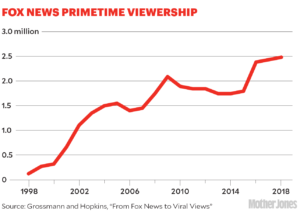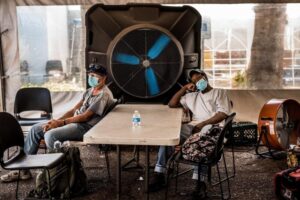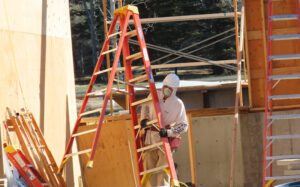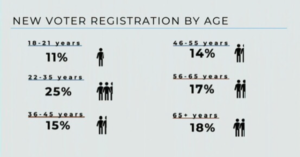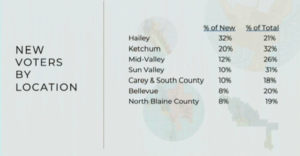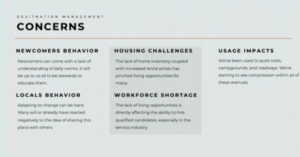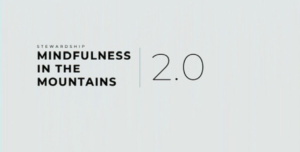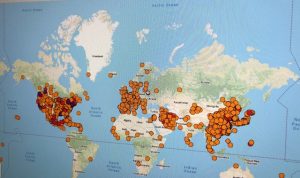ProPublica
True investigative journalism.
October 14, 2021When It Costs $53,000 to Vote
Mr. Winter is a staff photographer on assignment in Opinion. Mr. Wegman is a member of the editorial board.
‘Earlier this year we asked Floridians whose voting rights had been denied because of a criminal conviction to sit for photographs, wearing a name tag that lists not their name but their outstanding debt — to the extent they can determine it. This number, which many people attempt to tackle in installments as low as $30 a month, represents how much it costs them to win back a fundamental constitutional right, and how little it costs the state to withhold that right and silence the voices of hundreds of thousands of its citizens. The number also echoes the inmate identification number that they were required to wear while behind bars — another mark of the loss of rights and freedoms that are not restored upon release.
This is the way it’s been in Florida for a century and a half, ever since the state’s Constitution was amended shortly after the Civil War to bar those convicted of a felony from voting. That ban, like similar ones in many other states, was the work of white politicians intent on keeping ballots, and thus political power, out of the hands of millions of Black people who had just been freed from slavery and made full citizens.
Even as other states began reversing their own bans in recent years, Florida remained a holdout — until 2018, when Floridians overwhelmingly approved a constitutional amendment restoring voting rights to nearly everyone with a criminal record, upon the completion of their sentence. (Those convicted of murder or a felony sexual offense were excluded.)
Democratic and Republican voters alike approved the measure, which passed with nearly two-thirds support. Immediately, as many as 1.4 million people in the state became eligible to vote. It was the biggest expansion of voting rights in decades, anywhere in the country.
That should have been the end of it. But within a year, Florida’s Republican-led Legislature gutted the reform by passing a law defining a criminal sentence as complete only after the person sentenced has paid all legal financial obligations connected to it.
Even relatively small debts can be permanently disenfranchising for people who simply don’t bring in enough money to pay them off. General Peterson, 63, served a total of three and a half years on three convictions and believes he still owes around $1,100 in fees. He is retired and using his Social Security check to make monthly payments of $30 on the debt. “You want to help me pay it? That’d be fine with me,” he said.’
The vacuum created by the collapse of independent local news in America has given rise to ghost papers, partisan hackery, unverified rumors, and worse. Yet, new cohorts of news organizations are taking root to fill that void, often supported by philanthropy, public contributions, and new creative means of sustainability. At stake is the information that all citizens need to participate in democracy. S. Mitra Kalita, co-founder and CEO of URL Media, a network of Black-and Brown-owned media organizations sharing content, distribution, and revenues, and Stewart Vanderwilt, president and CEO of Colorado Public Radio, discuss the changing landscape of news gathering with Vivian Schiller, executive director of Aspen Digital at the Aspen Institute.
‘Civil’ Society
October 8, 2021Kurt Thigpen was met with vitriol shortly after he became a school board member in Washoe County, Nevada. Credit: David Calvert, special to ProPublica
We’re Losing Our Humanity, and the Pandemic Is to Blame
“What the hell is happening? I feel like we are living on another planet. I don’t recognize anyone anymore.”
by Sarah Smith
Kurt Thigpen clenched his hands around the edge of the table because if he couldn’t feel the sharp edges digging into his palms, he would have to think about how hard his heart was beating. He was grateful that his mask hid his expression. He hoped that no one could see him sweat.
A woman approached the lectern in the center aisle, a thick American flag scarf looped around her neck.
“Do you realize the mask, the CDC said it’s only 2% effective?” she demanded. “You’re failing our children, you’re failing our country, you’re failing our students’ future ….”
Thigpen fixed his eyes on a spot in the back of the blue-and-green auditorium. He let the person speaking at the lectern fade. It will be over soon, he told himself.
“No, you’re not the boss of me, you work for us, I can’t breathe with it on —”
“Ma’am —”
“Don’t you dare cut my microphone —”
The crowd cheered. Thigpen focused on his breathing.
It will end soon, he told himself. It must. His sweat turned cold under his suit.
“The science isn’t there, take the kids outta the masks and let’s move on.”
When the eight-hour meeting finally ended, he would drive home and pull off the suit and rip off his shirt. He would only take care with his rainbow tie, resting it gently in the closet. It still hangs there today. He would close the door, lay down on his bed, and let himself cry.
The stories of cruel, seemingly irrational and sometimes-violent conflicts over coronavirus regulations have become lingering symptoms of the pandemic as it drags through its second year. Two men on a Mesa-to-Provo flight got into a cross-aisle fight after one refused to wear a mask. A Tennessee teenager asking his school board to impose a mask mandate in honor of his grandmother who died of COVID-19 got jeered by the crowd. A California parent angered by the requirement that his child wear a mask allegedly beat up a teacher so badly that the teacher had to go to the emergency room. An Arizona father showed up to an elementary school with zip ties, allegedly intending to make a “citizen’s arrest” over COVID-19 rules. A Missouri medical center has distributed panic buttons to about 400 employees after an increase in assaults on health care workers by people frustrated over coronavirus-induced visitation restrictions and long wait times.
“What the hell is happening?” said Rachel Patterson, who owns a hair salon in Huntsville, Alabama, and who has been screamed at, cussed out and walked out on for asking clients to don a mask. “Like, I feel like we are living on another planet. Like I don’t — I don’t recognize anyone anymore.”
Full piece: https://www.propublica.org/article/were-losing-our-humanity-and-the-pandemic-is-to-blame
Upworthy:
The National School Boards Association sent a letter to the Biden Administration stating that, “These heinous actions could be the equivalent to a form of domestic terrorism and hate crimes.”
The threats have prompted U.S. Attorney General Merrick Garland to address the issue. In response, Garland directed federal authorities to meet with local law enforcement over the next month to discuss strategies for addressing the increase in “harassment, intimidation and threats of violence against school board members, teachers and workers” in public schools across the country.
Just about every American would agree that we should work to protect school board members from threats of violence. However, Fox News reporter Peter Doocy used Garland’s decision to crack down on violent threats as a way to rile up conservatives.
Just about every American would agree that we should work to protect school board members from threats of violence. However, Fox News reporter Peter Doocy used Garland’s decision to crack down on violent threats as a way to rile up conservatives.
He completely mischaracterized Garland’s directive in a question he asked White House Press Secretary Jen Psaki on Wednesday.
“Does the administration agree that parents upset about their kids’ curriculums could be considered domestic terrorists?” he asked.
“Let me unravel this a little bit,” Psaki answered, saying that Garland is “correct” to say that threats of violence against public servants “run counter to our nation’s core values.”
“Regardless of the reasoning,” she said, “threats and violence against public servants is illegal.”
FOX NEWS mandate from TV host Tucker Carlson [HuffPost]
Your response when you see children wearing masks as they play should be no different from your response when you see someone beat a kid in Walmart. Call the police immediately. Contact child protective services. Keep calling until someone arrives. What you’re looking at is abuse, it’s child abuse, and you’re morally obligated to attempt to prevent it.”
MOTHER JONES:
September/October issue
The Real Source of America’s Rising Rage
We are at war with ourselves, but not for the reasons you think.
by Kevin Drum
Americans sure are angry these days. Everyone says so, so it must be true.
But who or what are we angry at? Pandemic stresses aside, I’d bet you’re not especially angry at your family. Or your friends. Or your priest or your plumber or your postal carrier. Or even your boss.
Unless, of course, the conversation turns to politics. That’s when we start shouting at each other. We are way, way angrier about politics than we used to be, something confirmed by both common experience and formal research.
When did this all start? Here are a few data points to consider. From 1994 to 2000, according to the Pew Research Center, only 16 percent of Democrats held a “very unfavorable” view of Republicans, but then these feelings started to climb. Between 2000 and 2014 it rose to 38 percent and by 2021 it was about 52 percent. And the same is true in reverse for Republicans: The share who intensely dislike Democrats went from 17 percent to 43 percent to about 52 percent.
Likewise, in 1958 Gallup asked people if they’d prefer their daughter marry a Democrat or a Republican. Only 28 percent cared one way or the other. But when Lynn Vavreck, a political science professor at UCLA, asked a similar question a few years ago, 55 percent were opposed to the idea of their children marrying outside their party.
Or consider the right track/wrong track poll, every pundit’s favorite. Normallythis hovers around 40–50 percent of the country who think we’re on the right track, with variations depending on how the economy is doing. But shortly after recovering from the 2000 recession, this changed, plunging to 20–30 percent over the next decade and then staying there.
Finally, academic research confirms what these polls tell us. Last year a team of researchers published an international study that estimated what’s called “affective polarization,” or the way we feel about the opposite political party. In 1978, we rated people who belonged to our party 27 points higher than people who belonged to the other party. That stayed roughly the same for the next two decades, but then began to spike in the year 2000. By 2016 it had gone up to 46 points—by far the highest of any of the countries surveyed—and that’s beforeeverything that has enraged us for the last four years.
Are we paying attention?
May 18, 2021ProPublica updated this report from September, 2020. I missed it the first time published, and now already seeing population shifts in the Mountain West, specifically, the Wood River Valley in South-Central Idaho. -dayle
This article, the second in a series on global migration caused by climate change, is a result of a partnership between ProPublica and The New York Times Magazine, with support from the Pulitzer Center.
Senior citizens at a cooling center in Phoenix [summer 2020] during Arizona’s record-setting heat wave. (Meridith Kohut for The New York Times)
Climate Change Will Force a New American Migration
“Wildfires rage in the West. Hurricanes batter the East. Droughts and floods wreak damage throughout the nation. Life has become increasingly untenable in the hardest-hit areas, but if the people there move, where will everyone go?
The millions of people moving north will mostly head to the cities of the Northeast and Northwest, which will see their populations grow by roughly 10%, according to one model. Once-chilly places like Minnesota and Michigan and Vermont will become more temperate, verdant and inviting. Vast regions will prosper; just as Hsiang’s research forecast that Southern counties could see a tenth of their economy dry up, he projects that others as far as North Dakota and Minnesota will enjoy a corresponding expansion. Cities like Detroit; Rochester, New York; Buffalo and Milwaukee will see a renaissance, with their excess capacity in infrastructure, water supplies and highways once again put to good use. One day, it’s possible that a high-speed rail line could race across the Dakotas, through Idaho’s up-and-coming wine country and the country’s new breadbasket along the Canadian border, to the megalopolis of Seattle, which by then has nearly merged with Vancouver to its north.”
Sun Valley’s Population Explodes During Pandemic Year
Eye on Sun Valley
|
https://eyeonsunvalley.com/Mobile/Mobile_Story_Reader?StoryId=8355
Idaho Mountain Express
by Greg Foley
Sun Valley tourism is rebounding, marketing group says
Report: Some 1,500 people have moved to valley during pandemic
The Sun Valley area is undergoing an unexpected surge in growth amid the COVID-19 pandemic, changing life for locals and—to some degree—how Idaho’s premier tourist destination is marketed to potential visitors.
That was the overarching message of a semi-annual meeting conducted by the Visit Sun Valley marketing and business organization livestreamed to viewers Wednesday from The Community Library in Ketchum.
Many people coming to the area are “COVID evacuees,” remote workers, adventurers and people who own second—or third—homes in the area, he said. Amid the pandemic, Visit Sun Valley has had to consider that visitors are booking trips later, staying longer and have been looking for things to do, as many events were canceled, he said. Group visits were down, hotel bookings were down and there have been fewer “traditional” vacations of families flying in for a week-long visit. Instead, more people have been driving to the Wood River Valley from places such as Salt Lake City, Boise and Twin Falls, he said.
“It just hasn’t been the same as it was historically,” Fortner said.
The organization sees a “pent-up demand” for travel, the return of many popular events, increased confidence in the safety of travel, a strong interest in mountain communities and strong commercial air service to the region all as encouraging factors for the tourism sector, Fortner said. In addition, many people are conducting internet searches for Sun Valley, he noted.
As the organization moves into a new phase of its “Mindfulness in the Mountains” marketing campaign, it is encouraging community “stewardship” from visitors—people who are a “better visitor that is enlightened and informed,” the organization’s presentation stated.
In addition, Visit Sun Valley is promoting a wide range of “guided experiences”—including cooking classes, yoga, fly fishing and mountain biking—that educate visitors, get them outdoors and allow them to gain a “deeper sense of what Sun Valley is all about,” said Marketing Director Ray Gadd. Visit Sun Valley is also promoting the return of signature events, including the Sun Valley Music Festival, the Sun Valley Writers’ Conference and the Trailing of the Sheep Festival, Gadd said.
During the meeting, David Patrie, outreach director for the Sun Valley Economic Development business organization, presented data from an in-depth analysis of the effects of the pandemic and an influx of new residents into the Wood River Valley over the past year.
“Last March, we never would have predicted where we are today,” Patrie said.
New voter registrations in Blaine County increased from 1,640 in 2016 to 3,770 in 2020, Patrie said, with most registrants in the 22-35 age range.
“Yeah, it’s a lot,” he said, “and it feels like a lot.”
Now, it’s the rollout.
December 18, 2020What is happening.
- Pfizer
- Vaccine
- Moderna
- Indiana
- Pence
COVID vaccine rollout, a colossal mess.
Ed Yong, The Atlantic:
12.17.20
“I think there has been a certain amount of naïveté on the part of the government about what it actually takes to turn vaccines into vaccinations,” he says. “Unless we actually put more funding into this particular area, it’s going to be a bit tragic, because we’re going to have vaccines, but we’re going to fall at the last hurdle.” [NPR]
Idaho Statesman:
[by Rachel Roberts]
“Idaho will not receive as many doses of the Pfizer COVID-19 vaccine next week as it originally expected, according to the Idaho Department of Health and Welfare.
Idaho’s allotment for next week was reduced from 17,550 to 9,750 doses.
Idaho isn’t the only state reporting a reduced second shipment, according to reports from The Washington Post and other news outlets. Florida, Illinois, Iowa, Kansas, Missouri, Oregon, Rhode Island and Washington were among the other states receiving fewer vaccines.”
From Politifact/Poynter Institute:
“Vice President Mike Pence tweeted: “On January 13, 2020 @moderna_tx partnered with President @realDonaldTrump & @NIH to develop a vaccine for the American people! Today, Moderna announced their vaccine is 95% EFFECTIVE! Operation Warp Speed is a success because of the strong leadership of this President!”
In their own recent announcements, Moderna gave Operation Warp Speed a nod, while Pfizer didn’t mention it. That can be explained by the different partnerships the Trump administration struck with the two companies.
The federal government’s deal with Pfizer would pay for the purchase of the company’s vaccine if it gets FDA emergency use authorization or approval. So Pfizer hasn’t gotten any Warp Speed funding yet. With Moderna and other companies, by contrast, the government is helping to fund the vaccines’ development and various efforts to scale up manufacturing.
Those differences may influence who can claim the credit for the breakthroughs at this stage.”
CNN/12.17.20
[By Ellie Kaufman, Sara Murray and Priscilla Alvarez]
“Multiple states have been told by the federal government to expect fewer doses of Pfizer’s Covid-19 vaccine than initially promised, leaving health officials across the country confused and frustrated about the crucial rollout plans just days after the first doses were shipped.
Officials in numerous states including Iowa, Illinois, Washington, Michigan and Oregon have said that they have been recently told they would receive fewer doses than originally planned for by the federal government’s Operation Warp Speed.
The cause of delay remains unclear to many, and comes as infection rates are spiking across the country. On Thursday, Pfizer put out a statement that the company was “not having any production issues” and that “no shipments containing the vaccine are on hold or delayed.”
“We have millions more doses sitting in our warehouse but, as of now, we have not received any shipment instructions for additional doses,” Pfizer said.
ProPublica/09.23/20
[by Issac Arnsdorf]
ProPublica is a nonprofit newsroom that investigates abuses of power.
AND.
ProPublica’s board chairman, Paul Sagan, is a member of Moderna’s board and a company stockholder.
“Trump’s vaccine Czar refuses to give up stock in drug company involved in his government role.
The administration calls Moncef Slaoui, who leads its vaccine race, a “contractor” to sidestep rules against personally profiting from government positions. Slaoui owns $10 million in stock of a company working with his team to develop a vaccine.
“Congress should strengthen the federal ethics laws to root out this kind of corruption,” Sen. Elizabeth Warren, D-Mass., said at a congressional hearing. “And the first person to be fired should be Dr. Slaoui. The American people deserve to know that COVID-19 decisions are based on science and not on personal greed.”
ABC News/7.7.20
[by Sony Salzman]
Though their journeys to a COVID-19 vaccine have been eerily similar, the companies themselves could not be more different Pfizer is a multinational pharmaceutical giant, while Moderna is a small biotechnology company that has never brought a drug to the market.
Reuters
[by Marisa Taylor, Robin Respaut]
“The federal government is supporting Moderna’s vaccine project with nearly half a billion dollars and has chosen it as one of the first to enter large-scale human trials.
But the company – which has never produced an approved vaccine or run a large trial – has squabbled with government scientists over the process, delayed delivering trial protocols and resisted experts’ advice on how to run the study, according to three sources familiar with the vaccine project. The sources said those tensions, which have not been previously reported, have contributed to a delay of more than two weeks in launching the trial of the Moderna’s vaccine candidate, now expected in late July.
In one disagreement, Moderna executives resisted experts’ insistence on close monitoring of trial participants who might contract COVID-19 for changes in oxygen levels that could signal dangerous complications. While other drugmakers complied, Moderna questioned the recommendation as a “hassle” that slowed development, one of the sources told Reuters. Jordan said the company preferred to defer all decisions about monitoring to patients’ physicians but that the company ultimately agreed to some monitoring.
The Trump administration’s “Operation Warp Speed” vaccine program is run by HHS in partnership with other agencies. It is led by Moncef Slaoui, a former GlaxoSmithKline executive who more recently served on Moderna’s board of directors. He stepped down in May to run the government’s COVID-19 vaccine project.”
Moderna outsourced the handling of data collection to the contract research firm PPD Inc. At one meeting set up with the leading companies and government officials, Moderna did not allow PPD to share details of the trial plans, as other companies had done, the sources said. PPD did not respond to request for comment.
The U.S. is a mess, friends. COVID and hacks. And he has power for 33 more days.
311,000 deaths.
17.3 million cases.
[AXIOS]
UPDATE
12.18.20
In the last week alone, 1 out of every 220 Americans was diagnosed with the coronavirus — an astronomically large portion of the population to be sick at the same time, Axios’ Dani Alberti and Sam Baker write.
- About 1 in 20 have been diagnosed since the pandemic began.
Why it matters: The new infections will translate into large numbers of hospitalizations, and eventually deaths, in the coming weeks.
- It also means the rest of us have a decent chance of interacting with someone who is infected, anywhere we go.
UPDATE
12.18.20
5:50 pm Mountain Time
Business Insider
[by Emily Graffeo]
- Moderna slumped as much as 6.2% on Friday as investors sold off on encouraging news regarding the company’s coronavirus vaccine.
- A panel of Food and Drug Administration experts recommended the vaccine be approved for emergency use on Thursday, a key step that will set the shot up for distribution in the United States as soon as next week.
- Investors are likely taking profits from the stocks 600% year-to-date rally. Shares of Moderna traded around $137 Friday morning.
CNBC
by MacKenzie Sigalos
In February, Health and Human Services Secretary Alex Azar invoked the Public Readiness and Emergency Preparedness Act. The 2005 law empowers the HHS secretary to provide legal protection to companies making or distributing critical medical supplies, such as vaccines and treatments, unless there’s “willful misconduct” by the company. The protection lasts until 2024.
That means that for the next four years, these companies “cannot be sued for money damages in court” over injuries related to the administration or use of products to treat or protect against Covid.
Forbes
[by Giacomo Tognini]
Three men have become billionaires in 2020 thanks to Moderna’s stunning rise, with the stock up more than 600% since the beginning of January. Stephane Bancel, 47, joined the company as its CEO in 2011 — one year after its founding — and owns a 7% stake along with a sizable chunk of stock options, giving him an estimated net worth of $4.5 billion. Springer and Langer were both founding investors in the firm and have never sold a share, according to Securities and Exchange Commission filings. Springer owns a 3.5% stake in Moderna, part of a $2.2 billion fortune (down from $2.6 billion on December 8); Langer owns 3%, part of his estimated $1.7 billion net worth (down from $2 billion 10 days ago).
Analysts expect Moderna to post $800 million in sales in 2020 thanks in part to government funding for its Covid-19 vaccine program, up from $60.2 million last year. That could balloon to as much as $10 billion revenue in 2021 as the vaccine is rolled out across the globe. Moderna shares are expected to remain volatile in the near future as investors have already priced in the anticipated FDA approval and will now look to the company’s profitability beyond its Covid-19 vaccine. “The approval is an important positive, but it was widely expected already,” says Michael Yee, an analyst at investment bank Jefferies.
NPR
[by Tom Dreisbach/10.4.2020]
From a relative unknown, to a key player in the vaccine race
Modern launched in 2010 with a headquarters based in Cambridge, Mass., focused on using a technology called messenger RNA (or mRNA) to develop vaccines and therapeutics. The mRNA technology has been widely considered innovative, but remains largely unproven.
The company has never brought a product to market.
In early January, Moderna was trading for under $20 per share, and was valued at around six billion dollars.
Then Moderna announced that it had started collaborating on a coronavirus vaccine with scientists from the National Institute of Allergy and Infectious Diseases, which is led by Dr. Anthony Fauci.
By April, the government had committed half a billion dollars to the Moderna vaccine project as part of Operation Warp Speed.
Since then, the company’s stock price has exploded. Press releases suggesting positive news from the scientific trials, or announcing additional commitments of taxpayer funding sent the share price to a peak of around $95, before dropping to between $60-$70 in recent months. The company is now valued at around $25 billion.
On April 12, 1955, the day the Salk vaccine was declared “safe, effective and potent,” legendary CBS newsman Edward R. Morrow interviewed its creator and asked who owned the patent. “Well, the people, I would say,” said Salk in light of the millions of charitable donations raised by the March of Dimes that funded the vaccine’s research and field testing. “There is no patent. Could you patent the sun?”
Local Journalism
March 30, 2020‘Like many in business, trusted news organizations are being hit hard by this pandemic. If you can, please consider subscribing to your local paper or contributing to a VT news organization. You deserve transparency and the truth, and they work hard to keep you informed.
-Vermont Governor Phil Scott
NYTimes
Ben Smith
“Abandon most for-profit local newspapers, whose business model no longer works, and move as fast as possible to a national network of nimble new online newsrooms. That way, we can rescue the only thing worth saving… the journalists.”
Bail Out Journalists. Let Newspaper Chains Die.
The coronavirus is likely to hasten the end of advertising-driven media, our columnist writes. And government should not rescue it.
“There’s all this ‘doom and gloom for local journalism stories’ that have happened in the last week or so, and I hope that other people see what we’re doing and understand that the important thing is the journalism — it’s the stories, it’s the investigations — that’s what matters,” Ken Ward said. He will also be on the staff of the nonprofit investigative powerhouse ProPublica and will have support from Report for America, another growing nonprofit organization that sends young reporters to newsrooms around the country.
The news business, like every business, is looking for all the help it can get in this crisis. Analysts believe that the new federal aid package will help for a time and that the industry has a strong case to make. State governments have deemed journalism an essential service to spread public health information. Reporters employed by everyone from the worthiest nonprofit group to the most cynical hedge fund-owned chain are risking their lives to get their readers solid facts on the pandemic, and are holding the government accountable for its failures. Virtually every news outlet reports that readership is at an all-time high. We all need to know, urgently, about where and how the coronavirus is affecting our cities and towns and neighborhoods.
So what comes next? That decision will be made in the next few months — by public officials, philanthropists, and other tech companies, and people like you.
The right decision is to consistently look to the future, which comes in a few forms. The most promising right now is Ms. Green’s dream of a big new network of nonprofit news organizations across the country on the model o The Texas Tribune, which Mr. Thornton co-founded. There are also a handful of local for-profit news outlets, like The Seattle Times, The Los Angeles Times and The Boston Globe, with rich and civic-minded owners, and The Philadelphia Inquirer, which is owned by the non-profit Lenfest Institute for Journalism. And there is a generation of small, independent membership or subscription sites and newsletters like Berkeleyside.
Elizabeth Green, a founder of Chalkbeat, a nonprofit news organization reporting on education issues, in Washington, D.C.
[Avi Schiffmann]
The High Schooler Who Became a COVID-19 Watchdog
The New Yorker
by Brent Crane
In December, DT said, “We have a problem that, a month ago, nobody thought about.” Well, somebody did. On December 29th, as DT vacationed with his family at Mar-a-Lago, Avi Schiffmann, a seventeen-year-old from Washington State, launched a homemade Web site to track the movement of the coronavirus. Since then, the site, ncov2019.live, has had more than a hundred million visitors. “I wanted to just make the data easily accessible, but I never thought it would end up being this big,” the high-school junior said last week over FaceTime. Schiffmann, gap-toothed and bespectacled, was sitting on his bed wearing a blue T-shirt and baggy pajama bottoms. It was late morning. He was at his mother’s house, on Mercer Island, outside Seattle.
Using a coding tactic known as “web-scraping,” Schiffmann’s site collates data from different sources around the globe—the W.H.O., the C.D.C., Yonhap News Agency in South Korea—and displays the latest number of covid-19 cases. It features simple graphics and easy-to-read tables divided by nation, continent, and state. Data automatically updates every minute. In a politicized pandemic, where rumor and panic run amok, the site has become a reputable, if unlikely, watchdog.
He began teaching himself to code when he was seven, mainly by watching YouTube videos, and has made more than thirty Web sites. “Programming is a great creative medium,” he said. “Instead of using a paintbrush or something, you can just type a bunch of funky words and make a coronavirus site.” One of his first projects, in elementary school, was what he calls “a stick-figure animation hub.” Later sites collated the scores for his county’s high-school sports games, aggregated news of global protests, and displayed the weather forecast on Mars. “His brain is constantly going from one thing to another, which is good, but I also try to focus him in,” his mother, Nathalie Acher, said. “I’m not techy at all myself. I see it as just really boring. He sees it as an art form.”
Schiffmann took the virus threat seriously before many others did. “I’ve been kind of concerned for a while, because I watched it spread very fast, and around the entire world. I mean, it just kind of went everywhere.” He took his own precautions. “I got masks a while ago. I got, like, fifteen for seventeen dollars. Now you can’t even buy a single mask for, like, less than forty.” His mother chimed in. “I wish I had listened to him,” she said. “But, in his teen-ager way, he’d come down the stairs with his eyes huge and be, like, ‘There are fifty thousand more cases!’ and I’d be, like, ‘Yeah, but they’re over there, not here.’ ”
Her son is a C student.
Now that the grownups of the world are finally, and appropriately, freaking out, it is hard for Schiffmann not to feel righteous vindication. “If you told someone three months ago that we should spend, like, ten billion dollars in upgrading the United States’ health care, they would have been, like, ‘Nah,’ ” he said. “Now, everyone’s, like, ‘Oh, my God, yes.’ But this is the kind of stuff we should have done a long time ago.”
Young people give me so much hope. ❥ -dayle
Journalism: Exposing Privacy
November 4, 2017Incredibly well reported and researched. And deeply moving.
Radiolab
First aired on 9.25.17
‘Now What Am I Known For?’ Trying to Find Oliver Sipple’s Legacy
by Latin Nasser
Our latest episode tells the story of Oliver Sipple, a Vietnam vet who went for a walk one day, and ended up saving then-President Gerald Ford from an assassin’s bullet. A day later, renowned gossip columnist Herb Caen – in conjunction with the activist Harvey Milk – outed Sipple as gay. Sipple hadn’t told his family. The revelation made national news and he eventually sued several newspapers for invading his privacy.
[…]
Trying to capture something so evanescent as a reaction to a headline forty years after the fact is no small challenge, but we started calling up some organizations we thought might be able to help. Turns out, we didn’t have much luck. But in all those calls, we did talk to two people who shared what Sipple and his story meant to them. And – although we had to cut them from our story for time – we still wanted to share snippets from those conversation.
http://www.radiolab.org/story/sipple-legacy/
More on reporting privacy with a focus on the digital age and the ease of exposing privacy with massive and often debilitating effects.
What is ‘doxing’?
ProPublica
11.4.17
Remember Gamergate?
Or when the identity of that dentist who killed Cecil the Lion was posted?
Or that man who was wrongly identified as the Boston Marathon bomber?
These were all examples of how making someone’s personal, and sometimes private, information public on the internet led to intense harassment.
Today, each of the cases could easily be termed a form of doxxing—shorset for “dropping documents.” In the last few years, doxxing has increasingly been used as an online weapon to attack people. People’s “documents”—records of their addresses, relatives, finances—get posted online with the implicit or explicit invitation for others to shame or hector them.
But while doxxing may seem both creepy and dangerous, there is no single federal law against the practice. Such behavior has to be part of a wider campaign of harassment or stalking for it to be against the law.
This week I wrote about “doxxing” among the more extreme elements of the country’s political left and right, a world of zealotry and paranoia and anger and worry. Over the course of my reporting, the subject of my article got doxxed herself.
It was all fascinating and disturbing, and I think leaves people, myself included, with a lot to think about concerning doxxing—its effectiveness and appropriateness both. Reporters, after all, have been doing a form of doxxing for decades.
But to hope of thinking clearly about doxxing, it always helps to better understand it and its practitioners.
So, how do doxxers dox? They use public records, like property records, tax documents, voter registration databases; they scour social media, real estate websites, and even do real-life surveillance to gather information. Then, they publish the information online.
For some, doxxing is morally troubling. Law professor Danielle Citron is one. “It provides a permission structure to go outside the law and punish each other,” she says. “It’s like shaming in cyber-mobs.”
Then, there is the matter of doxxing the wrong person.
Here’s an example: After the infamous “Unite the Right” protest in Charlottesville, an attendee wearing an “Arkansas engineering” shirt was identified as Kyle Quinn, a professor at the University of Arkansas. Except Kyle Quinn wasn’t in Charlottesville. That didn’t stop the internet, and so when “Kyle Quinn” was doxxed as one of those torch-bearing protesters in Charlottesville, Quinn spent a weekend in hiding due to the amount of online abuse he subsequently received. The real protester, a former engineering student named Andrew M. Dodson, later apologized.
In some cases, people doxxed after taking part in white supremacist marches have been arrested, lost their jobs, or allegedly been disowned by their families.
Other experts question whether doxxing white supremacists is a useful tactic. “Is this an effective means of challenging racist views?” ask Ajay Sandhu and Daniel Marciniak, researchers at the University of Essex in the United Kingdom. They argue that doxxing simply isolates people, forcing them into smaller parts of the internet. “You don’t really challenge them, you allow them to exist in those isolated spaces,” Sandhu says.
How do you protect yourself from doxxing? The short answer is: You probably can’t fully. But we have a few tips that will help make the information you want kept private more secure.
—Decca Muldowney






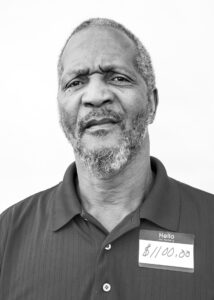




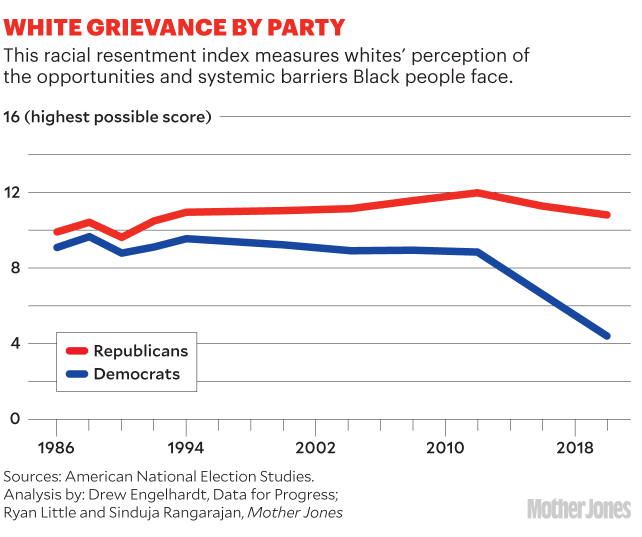 What do we know about more recent views of racism? One thing we know for sure is that both white and Black Americans have gotten
What do we know about more recent views of racism? One thing we know for sure is that both white and Black Americans have gotten 